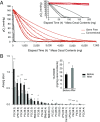Microbes vs. chemistry in the origin of the anaerobic gut lumen
- PMID: 29610310
- PMCID: PMC5910840
- DOI: 10.1073/pnas.1718635115
Microbes vs. chemistry in the origin of the anaerobic gut lumen
Erratum in
-
Correction for Friedman et al., Microbes vs. chemistry in the origin of the anaerobic gut lumen.Proc Natl Acad Sci U S A. 2022 Jun 14;119(24):e2207826119. doi: 10.1073/pnas.2207826119. Epub 2022 Jun 6. Proc Natl Acad Sci U S A. 2022. PMID: 35666878 Free PMC article. No abstract available.
Abstract
The succession from aerobic and facultative anaerobic bacteria to obligate anaerobes in the infant gut along with the differences between the compositions of the mucosally adherent vs. luminal microbiota suggests that the gut microbes consume oxygen, which diffuses into the lumen from the intestinal tissue, maintaining the lumen in a deeply anaerobic state. Remarkably, measurements of luminal oxygen levels show nearly identical pO2 (partial pressure of oxygen) profiles in conventional and germ-free mice, pointing to the existence of oxygen consumption mechanisms other than microbial respiration. In vitro experiments confirmed that the luminal contents of germ-free mice are able to chemically consume oxygen (e.g., via lipid oxidation reactions), although at rates significantly lower than those observed in the case of conventionally housed mice. For conventional mice, we also show that the taxonomic composition of the gut microbiota adherent to the gut mucosa and in the lumen throughout the length of the gut correlates with oxygen levels. At the same time, an increase in the biomass of the gut microbiota provides an explanation for the reduction of luminal oxygen in the distal vs. proximal gut. These results demonstrate how oxygen from the mammalian host is used by the gut microbiota, while both the microbes and the oxidative chemical reactions regulate luminal oxygen levels, shaping the composition of the microbial community throughout different regions of the gut.
Keywords: gut microbiota; luminal oxygen; microbial ecology; oxygen probes; phosphorescence quenching.
Conflict of interest statement
The authors declare no conflict of interest.
Figures




Similar articles
-
Correlation between intraluminal oxygen gradient and radial partitioning of intestinal microbiota.Gastroenterology. 2014 Nov;147(5):1055-63.e8. doi: 10.1053/j.gastro.2014.07.020. Epub 2014 Jul 18. Gastroenterology. 2014. PMID: 25046162 Free PMC article.
-
Aspirin Reduces Colorectal Tumor Development in Mice and Gut Microbes Reduce its Bioavailability and Chemopreventive Effects.Gastroenterology. 2020 Sep;159(3):969-983.e4. doi: 10.1053/j.gastro.2020.05.004. Epub 2020 May 6. Gastroenterology. 2020. PMID: 32387495
-
Ability of the gut microbiota to produce PUFA-derived bacterial metabolites: Proof of concept in germ-free versus conventionalized mice.Mol Nutr Food Res. 2015 Aug;59(8):1603-13. doi: 10.1002/mnfr.201500014. Epub 2015 May 12. Mol Nutr Food Res. 2015. PMID: 25820326 Free PMC article.
-
New approaches to secondary metabolite discovery from anaerobic gut microbes.Appl Microbiol Biotechnol. 2025 Jan 20;109(1):12. doi: 10.1007/s00253-024-13393-y. Appl Microbiol Biotechnol. 2025. PMID: 39831966 Free PMC article. Review.
-
The impact of intestinal inflammation on the nutritional environment of the gut microbiota.Immunol Lett. 2014 Dec;162(2 Pt A):48-53. doi: 10.1016/j.imlet.2014.04.014. Epub 2014 May 4. Immunol Lett. 2014. PMID: 24803011 Free PMC article. Review.
Cited by
-
Siderophore-Linked Ruthenium Catalysts for Targeted Allyl Ester Prodrug Activation within Bacterial Cells.Chemistry. 2023 Feb 7;29(8):e202202536. doi: 10.1002/chem.202202536. Epub 2022 Dec 21. Chemistry. 2023. PMID: 36355416 Free PMC article.
-
Methanobrevibacter smithii cell variants in human physiology and pathology: A review.Heliyon. 2024 Sep 6;10(18):e36742. doi: 10.1016/j.heliyon.2024.e36742. eCollection 2024 Sep 30. Heliyon. 2024. PMID: 39347381 Free PMC article. Review.
-
Engineered Escherichia coli Nissle 1917 with urate oxidase and an oxygen-recycling system for hyperuricemia treatment.Gut Microbes. 2022 Jan-Dec;14(1):2070391. doi: 10.1080/19490976.2022.2070391. Gut Microbes. 2022. PMID: 35491895 Free PMC article.
-
Antibiotic-induced gut metabolome and microbiome alterations increase the susceptibility to Candida albicans colonization in the gastrointestinal tract.FEMS Microbiol Ecol. 2020 Jan 1;96(1):fiz187. doi: 10.1093/femsec/fiz187. FEMS Microbiol Ecol. 2020. PMID: 31769789 Free PMC article.
-
Hyperglycemia is associated with duodenal dysbiosis and altered duodenal microenvironment.Sci Rep. 2023 Jul 7;13(1):11038. doi: 10.1038/s41598-023-37720-x. Sci Rep. 2023. PMID: 37419941 Free PMC article.
References
-
- Swidsinski A, Loening-Baucke V, Verstraelen H, Osowska S, Doerffel Y. Biostructure of fecal microbiota in healthy subjects and patients with chronic idiopathic diarrhea. Gastroenterology. 2008;135:568–579. - PubMed
-
- Sonnenburg JL, et al. Glycan foraging in vivo by an intestine-adapted bacterial symbiont. Science. 2005;307:1955–1959. - PubMed
Publication types
MeSH terms
Substances
Grants and funding
LinkOut - more resources
Full Text Sources
Other Literature Sources
Molecular Biology Databases

